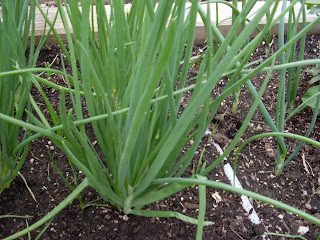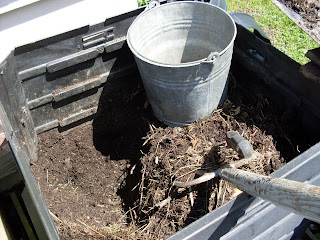 |
| BEFORE |
 |
| AFTER |
Harvest when the green tops are full. Pull onions from the middle of each bunch to let the outer onions continue to grow and spread.
Once you've harvested an entire bunch, add a bit of nourishing compost or manure to the soil and replant a new bulb immediately to keep a steady flow of green onions going throughout the season. They are great in salads, pasta dishes and delicious simply grilled on the BBQ, which I do all the time (brush with a little oil first - grill on top shelf - they caramelize - yum!).
Scallions add color and a delicate flavor to any dish. Here's my linguine recipe using green onions. I usually just wing the measurements, so adjust as you see fit.
LINGUINE WITH PANCETTA, MUSHROOMS AND SCALLIONS
INGREDIENTS
2-3 servings dried linguine
3 Tbspn. extra virgin olive oil (more as needed)
3 large fresh garlic cloves
3/4 cup sliced mushrooms
5-6 slices chopped pancetta (substitute bacon, ham or prosciutto)
3 green onions chopped (greens & white tips)
1/3 - 1/2 cup Feta cheese (to taste)
1 Tbspn finely chopped fresh parsley garnish
(Note to Vegetarians: substitute asparagus for pancetta.)
DIRECTIONS
Bring a large pot of heavily salted water to a hard boil.
Heat a sauté pan. Add olive oil. Sauté 3 cloves of freshly shaved (thinly sliced) garlic. Remove to a bowl after it turns translucent so it doesn't burn.
Get your linguine in the boiling water and cook per package (usually 7-11 minutes for dried) while you continue to sauté the remaining items.
In the garlicy olive oil, sauté sliced mushrooms and pancetta (do not crowd pan). A minute or two before the pasta is ready, sauté the green onions and return garlic to the hot pan. Crumble in feta cheese. Strain the linguine and add to the pan, mix together. Serve in pasta bowls with a sprinkling of fresh parsley.
Enjoy!






























